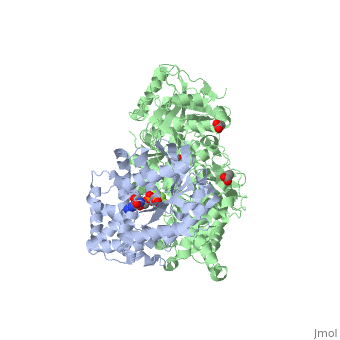PLC beta 3 Gq
From Proteopedia
(Difference between revisions)
| Line 15: | Line 15: | ||
PLC-β3 interacts with a surface on Gαq that <scene name='70/701452/Fig5/2'>overlaps almost completely</scene> with portions of Gα subunits needed for engagement of RGS proteins and the effector-binding region. Other effectors are known to engage the <scene name='70/701452/Fig3/2'>effector-binding site</scene> within Gα subunits. There are a large family of regulator of G protein signaling (RGS) proteins that independently accelerates the GTP hydrolysis in the <scene name='70/701452/Fig4/2'>GTPase domain</scene>. | PLC-β3 interacts with a surface on Gαq that <scene name='70/701452/Fig5/2'>overlaps almost completely</scene> with portions of Gα subunits needed for engagement of RGS proteins and the effector-binding region. Other effectors are known to engage the <scene name='70/701452/Fig3/2'>effector-binding site</scene> within Gα subunits. There are a large family of regulator of G protein signaling (RGS) proteins that independently accelerates the GTP hydrolysis in the <scene name='70/701452/Fig4/2'>GTPase domain</scene>. | ||
| - | The canonical Gα effector-binding region of Gαq, located between α3 and switch 2, is occupied by a helix-turn-helix (Hα1/Hα2) that immediately follows the C2 domain of PLC- β3. <scene name='70/701452/Pro862/ | + | The canonical Gα effector-binding region of Gαq, located between α3 and switch 2, is occupied by a helix-turn-helix (Hα1/Hα2) that immediately follows the C2 domain of PLC- β3. <scene name='70/701452/Pro862/3'>Pro862</scene> of PLC- β3 lies within the turn between Hα1 and Hα2, makes extensive contacts with multiple residues of Gαq, and forms the center of a Gαq-binding interface. |
<scene name='70/701452/Fig6/5'>The loop</scene> between the end of the TIM barrel and the beginning of the C2 domain comprises a second distinct segment of PLC- β3 that makes extensive contacts with active Gαq, including switches 1 and 2. This interface includes a series of interdigitated pairs of charged residues, specifically in PLC- β3-Gαq Asp709/Arg202, Lys710/Glu191, and Asp721/Lys41; these in turn are supported by additional charged residues Glu703 and Arg707 of PLC- β3. | <scene name='70/701452/Fig6/5'>The loop</scene> between the end of the TIM barrel and the beginning of the C2 domain comprises a second distinct segment of PLC- β3 that makes extensive contacts with active Gαq, including switches 1 and 2. This interface includes a series of interdigitated pairs of charged residues, specifically in PLC- β3-Gαq Asp709/Arg202, Lys710/Glu191, and Asp721/Lys41; these in turn are supported by additional charged residues Glu703 and Arg707 of PLC- β3. | ||
Revision as of 17:15, 8 July 2015
Unique bidirectional interactions of Phospholipase C beta 3 with G alpha Q
| |||||||||||
References
- ↑ Waldo GL, Ricks TK, Hicks SN, Cheever ML, Kawano T, Tsuboi K, Wang X, Montell C, Kozasa T, Sondek J, Harden TK. Kinetic Scaffolding Mediated by a Phospholipase C-{beta} and Gq Signaling Complex. Science. 2010 Nov 12;330(6006):974-80. Epub 2010 Oct 21. PMID:20966218 doi:10.1126/science.1193438
- ↑ Lyon AM, Tesmer JJ. Structural insights into phospholipase C-beta function. Mol Pharmacol. 2013 Oct;84(4):488-500. doi: 10.1124/mol.113.087403. Epub 2013 Jul, 23. PMID:23880553 doi:http://dx.doi.org/10.1124/mol.113.087403

